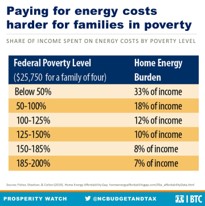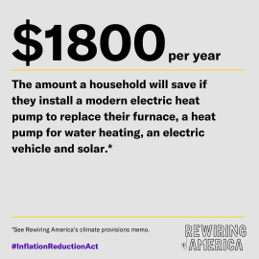As the United States rapidly accelerates the transition toward a low-carbon economy, consumers will play a crucial role. Our homes, cars, appliances, and transportation systems will change in ways large and small. To effectively transition our homes and vehicles will require a lot more coordination, awareness and action on the part of consumers.
Consider the incentives built into the 2022 Inflation Reduction Act (IRA). People will need to make decisions about whether to buy electric vehicles, solar panels and heat pumps and how to take advantage of energy efficiency incentives from their utilities. Extreme weather has triggered variable rate pricing and demand flexibility programs from utilities, which only succeed with the cooperation of their customers. In all of these scenarios, consumers have choices to make—choices that could support climate mitigation efforts or undermine them.
But not all communities will experience the energy transition equally. Underserved communities often lack the resources to prepare for and mitigate the severe weather events that climate change has made more frequent and extreme, such as heat waves and flooding. One recent study found that underserved communities were far less likely to have added rooftop solar to their homes. Even after controlling for income and homeownership, rooftop-solar adoption was 69% lower in predominantly Black communities, 30% lower in Hispanic communities, and 2% lower in Asian American and Pacific Islander (AAPI) communities.
The powerful benefits of electrification—such as cleaner communities and reduced electricity bills—must be accessible to everyone. Accessibility starts with understanding how our day-to-day energy decisions can reduce consumption and save money.
Equity Through Technology
While middle- and lower-income communities have less access to technology and information that can help them make energy decisions, their energy costs represent a much higher percentage of their overall spending compared to a higher income community. Families living well below the poverty level spend over one-third of their income on energy bills on average.
Technology like the Sense mobile app, which allows consumers to monitor their energy use and make informed energy decisions, is critical for middle and low-income individuals who have to make every dollar count. Energy equity requires that members of all communities have equal access to their own energy data.
In addition to making energy use data more accessible to everyday consumers, we must also address the substantial costs of electrifying millions of homes. Today, it requires a significant investment to be free of fossil fuel and live in a home that consumes cheaper renewable energy through electric appliances. Upgrading to a modern electric heat pump, an electric water heating pump, and rooftop solar panels can cost homeowners thousands of dollars. For the average American, those upfront costs can discourage the conversion to renewable energy in their household.
Rebates and other incentives will be essential to promoting electrification, but equally important is knowledge. How much electricity does my baseboard heating system use today? How much less electricity will I use if I upgrade to a heat pump? How much money can I save over the long term? These practical questions require insights into your own home’s energy usage.

Challenges in Achieving Energy Equity
Broadening the appeal of home energy technologies and engaging consumers around energy consumption will require significant change from the current approach. Until now, consumers have faced three distinct challenges when it comes to home energy data:
- Energy data was not provided to customers in real time. Instead, energy data was collected in 15-minute intervals and customers’ reports were delayed by hours or days. That’s like Google Maps providing traffic data minutes or hours after your daily commute – it’s not very helpful when you’re trying to make decisions while you’re in traffic.
- Making energy use data accessible. In the past, consumers needed to take the time to log into a web page, so it’s no wonder that engagement was very low. Whether rich or poor, most people today rely on their mobile phones for information. A mobile phone app can deliver informative, engaging, real-time data about their home energy.
- Smart home technology has been viewed as costly and difficult to install, partially due to the fact that a licensed electrician is required to install the technology. When the home energy app runs on a smart meter, there is no cost to the utility customer.
Now that the IRA is set to invest over $61 billion through both tax credits and direct rebates, American homeowners will have the means to offset smart home product up-front costs. For example, if a household requires an upgraded breaker box, they can receive up to $4,000 for the installation of a smart electrical panel with the High Efficiency Electric Home Rebate Act (HEEHRA) under the IRA.

The Path Forward: Programs & initiatives focused on energy equity
A new generation of smart meters has been designed with intelligence about the home’s energy use that is delivered to customers on a mobile app in real time. Utilities who use Sense technology on their meters give their customers access to a best-in-class experience without the cost and inconvenience of a separate install. When utilities offer the free Sense app as a service, customers are better equipped to monitor their energy consumption without needing to add smart home products to their homes.
By upgrading their individual homes and residential properties with smart home technologies, Americans will begin to feel economic benefits in addition to improved comfort and indoor air quality. The latest smart grid technologies allow electricity to be delivered using the current infrastructure, making it easier for utilities to get involved and deliver smart home intelligence to customers.
The Initiative for Energy Justice (IEJ) aims to achieve equity in the energy system for both social and economic participation beyond income-based rates and the dynamics of the need for discounted rates. Inflation is impacting American households nationwide, squeezing household budgets. But with real-time home intelligence technology like Sense, consumers can see significant energy bill relief year-over-year – which is a critical component of achieving energy equity. The entire team at Sense is working hard to make sure everyone can access its product, because we believe every consumer behind the meter matters.
